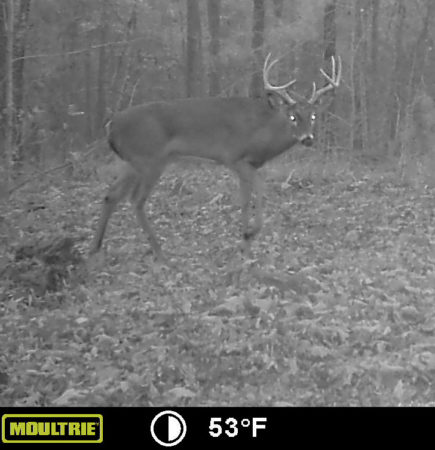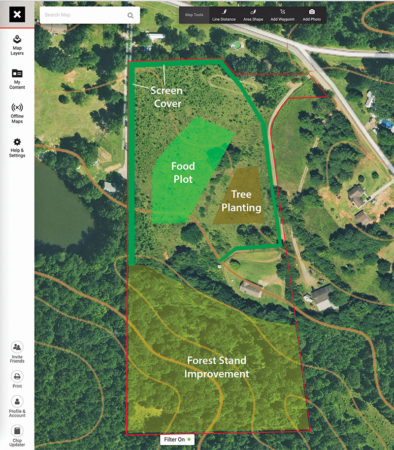I think it’s safe to say that 2020 is a year most of us won’t soon forget, no matter how hard we try. But for me, there was one bright spot that made an otherwise bleak year a very special one for myself and my family: the opportunity to purchase my first hunting property. The crazy story behind the purchase was fitting for 2020, but I’ll save that for another time. Let’s just say what started as a phone call to an absentee neighbor about buying an acre or two of property adjacent to ours ended with us selling our house and buying his 15-acre property.

My primary goals for the property are to provide a place for my family to hunt, the occasional opportunity to kill a mature buck, and to provide a place to experiment with various habitat management techniques. Fortunately my position as Communications Manager for the National Deer Association gives me the perfect outlet to share the journey and results through written articles like this one, website blog posts, and in a video series on our YouTube channel.
Like many small property owners, the time and money I devote to this project will be limited, as well as the equipment I have at my disposal, so the transformation won’t happen overnight.
Creating a Plan
Every good project should start with a plan of action, and so the first step in improving my 15 acres was to start developing mine. A management plan doesn’t have to be anything formal, but you should put it in writing for future reference and to track your progress. A good source to get you started is NDA’s free Management Plan template available for download on the NDA website at deerassociation.blackbaudwp.com under the Manage menu tab.
Taking Inventory
The first step in creating this plan is to take inventory of what you currently have on the property, followed by developing an “end vision” of how you ultimately want the property to look. The meat of the plan will be highlighting the steps you’ll need to take to get from point A (that beginning inventory) to point B (the end vision).

Trail-cameras placed on the property before closing revealed several bucks that should prove worthy adversaries in the upcoming season.
The great thing about owning a small property is that the inventory process can be completed pretty quickly. As you can see from the aerial imagery, my property is roughly divided in half, split by a creek and our house. The front (north) half of the property was previously used as cow pasture, but over the past 10 years was left to grow back up in thick young loblolly pines. In places the pines are just about impenetrable, but there are pockets of openings where fescue and blackberry brambles dominate. It’s certainly not great habitat in its current form, but deer are already bedding and traveling through this area heavily because it does provide excellent cover.
In contrast, the back (south) half of the property is a stand of mature hardwoods with a nice mix of white and red oaks, hickory, beech, poplar and sweetgum. It has a beautiful park-like look that would have had me wanting to hang a deer stand in my early years of hunting. What I’ve learned over the years, though, is that mature hardwoods with no understory provide virtually no benefit to white-tailed deer outside the brief, and often sporadic, times when acorns are dropping.
Another important piece of the habitat puzzle you’ll want to include in your inventory is the presence of any non-native, invasive species. Unfortunately, I have a few to contend with on the new property, but nothing that should be too difficult to get a handle on. To-date I have identified Chinese privet, Callery pear, English ivy, and the aforementioned fescue grass that needs to be eradicated.
When making management decisions, particularly on a small property, it’s critical to have an idea what’s on the surrounding properties as well. Knowing that can help you provide key habitat features that may be lacking in the general area. A good mapping app like onX can be a great resource for getting a birds-eye view of the surrounding properties and assessing their habitat.
In the case of my small tract, most of the surrounding properties look very similar to the back half of mine — mature hardwoods with some scattered stands of loblolly pines mixed in here and there. There is a large tract approximately a half-mile to the southeast that has food plots established for deer hunting that may provide some competition for attracting neighboring deer.
When creating a management plan, not only is it important to inventory your habitat, but it’s also a good idea to inventory the deer in the area as well. Prior to closing on the property, I was given permission to run trail-cameras to see what I had to look forward to. I was pleasantly surprised to see numerous bucks utilizing the area, with a few of them being solid 3½-year-old and older bucks. One thing that stood out to me, though, was that many of those deer disappeared in late November, once the leaves dropped. It may have simply been a post-rut shift in their travel patterns, but I suspect some of that shift had to do with how open the woods were once the leaves were off.
The End Goal
While my end vision for this property will undoubtedly change with time, I have some initial goals that I am working toward that I have laid out in the graphic below. Eventually I would like the front half of the property to consist of good screening cover along the property boundaries adjacent to neighboring homes and our driveway to give the deer a sense of security. Within those screened borders, I want thick, early successional habitat with rotated food plot strips in the center and some soft-mast trees like persimmons and crabapples to compliment the existing hard mast trees.
On the back half of the property, I want to leave a scattered mix of white and red oaks, along with a few beech and hickory. My goal is to have them spaced out enough to provide an open canopy and thick understory growth, which should result in excellent cover and year-round food. This will not only continue to provide an attraction when the acorns are falling, but it should also yield the necessary food and cover to attract deer year-round and help them feel secure to move during daylight hours.
The Journey

An important part of the planning process is to have an end vision of the project in mind that guides your management efforts.
While it’s nice to get out and explore what you have and dream about what you want it to be, years of managing public lands has taught me that the real satisfaction comes from seeing and being actively involved in the transformation. This is where the rubber meets the road. Since buying the property in December, what I’m quickly realizing is this is going to be a long-term project. I’m no longer working on public land, where I had great equipment, plenty of funds (most of the time), and 8+ hours a day to get the job done. Even though it’s just 15 acres, I’m now working with a very limited budget, limited time, and very little equipment at my disposal. And to top it all off, I’m not as young as I once was!
Keeping all this in mind, I’m trying to set reasonable goals and set a reasonable timeline for getting things done. My transformation will not happen overnight or even in a year’s time. I have to look at what needs to be done, prioritize when the work will be done, and have patience.
First Steps
Since the front half of the property is currently providing excellent cover, much of my initial focus will be on the back half. I do plan to get soil samples tested and proceed with planting a few trees before spring officially arrives, and I hope to plant a small food plot this fall, as well, but that will likely be the extent of improvements for the front tract in year one. That leaves plenty of work to get done in the back.
While I have a great supply of mast-producing trees, the openness of the understory really limits daytime deer movement. So my first order of business has been, and will continue to be, forest stand improvement (FSI). My method so far has been deciding which trees I want to keep and either dropping or killing what remains. For the most part I am dropping any that are 12 inches or less in diameter. Larger trees are girdled with a chainsaw and the cut is then sprayed with a concentrated glyphosate solution. This will hopefully kill the tree, so that even though the tree will still be standing, the lack of foliage will allow sunlight to reach the forest floor, providing the same benefit as if I had dropped it. It is worth mentioning that there are much better herbicide options out there to do this, but I already had glyphosate on hand, and this will be a good experiment to see how it performs on different tree sizes and species. My primary focus for tree removal are sweet gums, pines, and poplars, but I will undoubtedly have to remove some beech, hickory and even oaks to reach the desired level of thinning I’m after.
I can already tell you the FSI work is taking longer than I’d like as a solo project. In my mind, I thought I’d have all 7 to 8 acres done by this point, but now I’m just hoping to have it finished by deer season!
In conjunction with FSI work, my property desperately needs prescribed fire. The back half of the property is covered in a thick layer of hardwood leaves that have accumulated over the years, inhibiting understory growth. A good, slow burn should remove that duff layer of leaves without damaging the hardwoods, which should ultimately help speed up the release of valuable forbs, grasses and shrubs in the understory. Right now it remains to be seen if any burns will take place prior to deer season, as I still need to purchase some tools of the trade before I dive into burning, particularly a drip torch for lighting the fire, a leaf blower for my firebreaks, and at least one backpack sprayer to make sure the fire stays within the breaks. My hope is to have these in place in time for a June burn, but only time will tell!
Wrap Up
While I haven’t got to spend as much time working on the property yet as I’d like, I am excited about the work I’ve done and all the work yet to be done. After years of getting to improve habitat on public land, it feels good to be able to put some of that knowledge and experience to work on my own piece of ground — even if on a much smaller scale. My hope is not only that I’ll be able to see my kids, wife, and friends take deer off the property in the future, but that in my efforts, some of you can learn and create your own small deer hunting oasis.